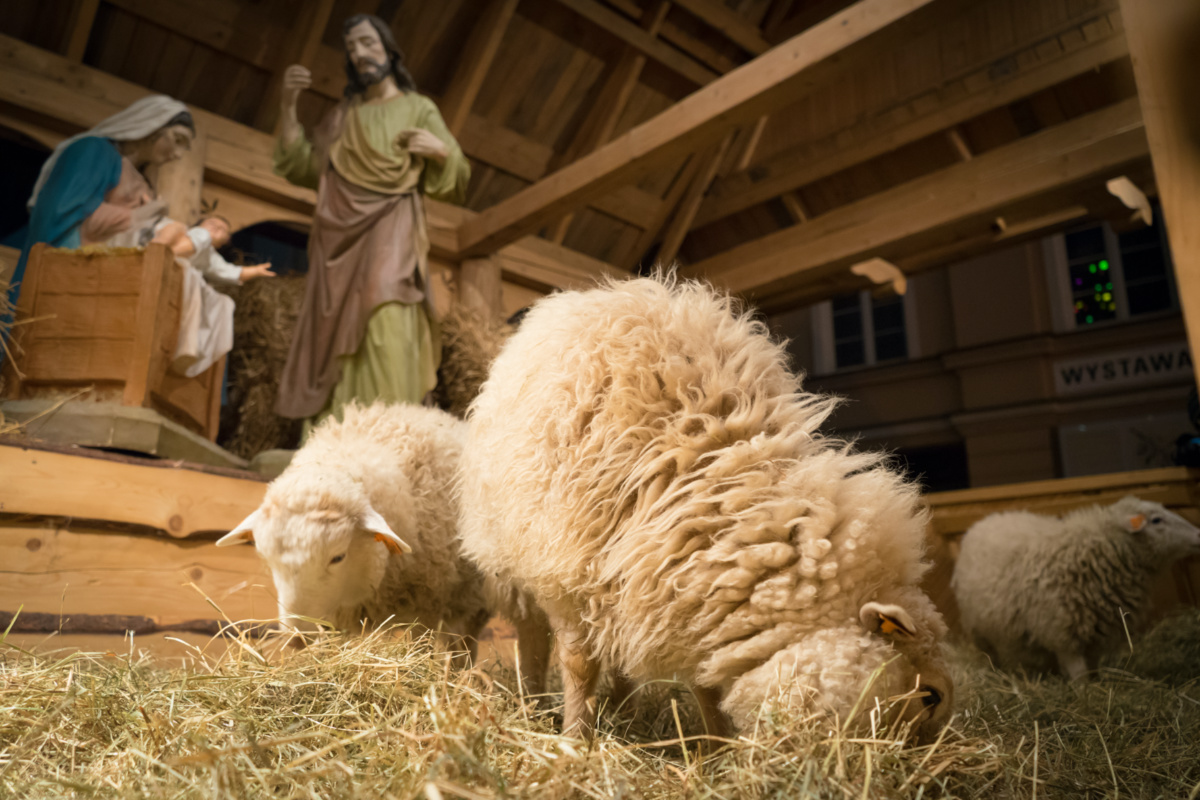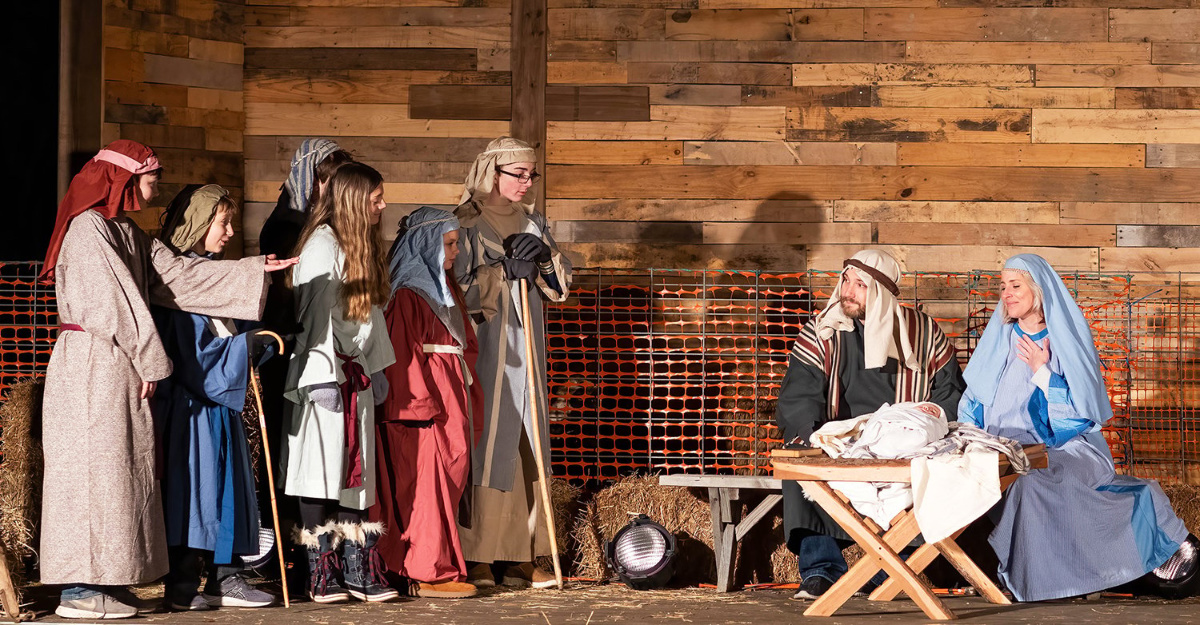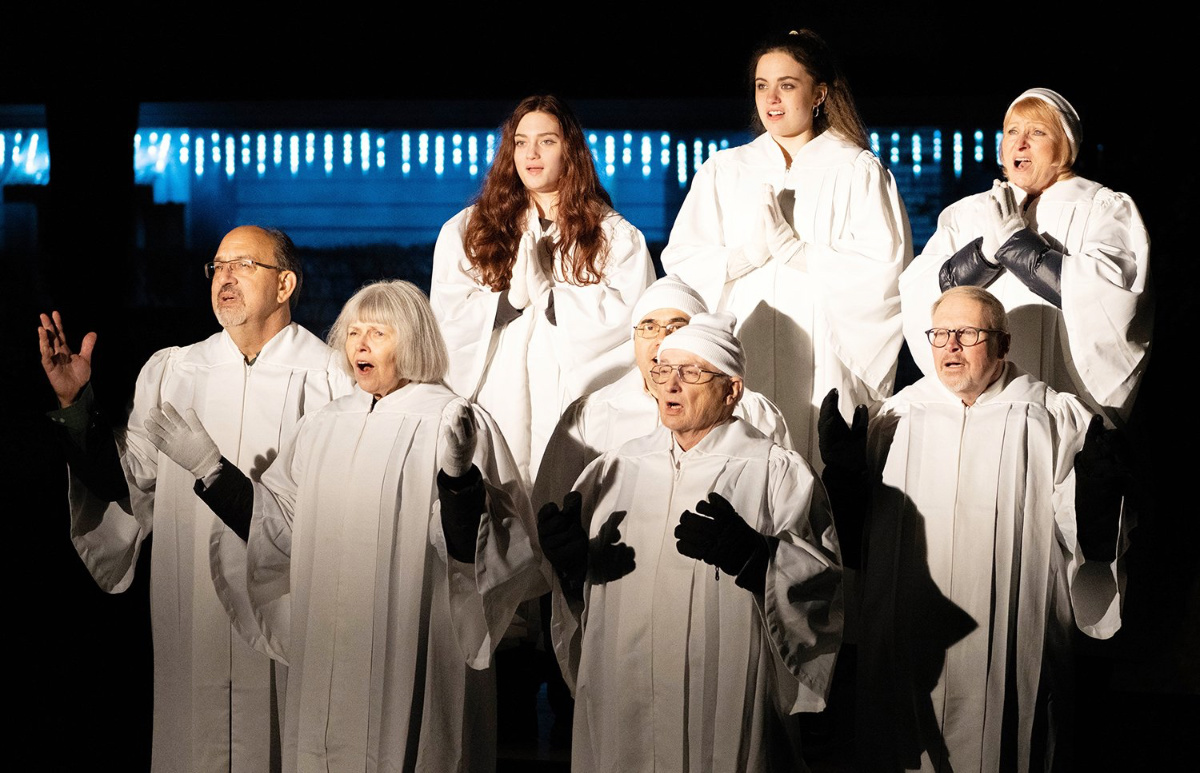
Though they aren’t mentioned in the Bible Christmas story, live animals have been part of nativity scenes since the 1200s. But, as BOB SMIETANA of Religion News Service, reports, sometimes things go awry, including a recent case of cows on the loose…
United States
RNS
David Baum has a warning for any church planning to do a live nativity: Watch out for the sheep.
“They’re like little tanks”, said Baum, recounting the time some sheep bolted, dragged a bale of hay behind them and “ran down some little old ladies singing Christmas carols.”

Sheep at a static nativity scene – those involved say they can cause mayhem at a live scene. PICTURE: Flexire/iStockphoto.
For the past few decades, Baum, owner of the Texas Camel Corps, has spent the Christmas season traipsing all over Texas, supplying camels – as well as donkeys, ox and sheep – for live nativity sets at churches around the state.
“We have got it all,” he said. “I tell people we bring everything but the baby Jesus.”
“They’re like little tanks.”
– David Baum, owner of the Texas Camel Corps, referring to sheep used in nativity scenes.
A live nativity at the Seaside Chapel in Carolina Beach, North Carolina, made headlines recently when a pair of cows staged a jailbreak from the manger and dove into a river – leading to an overnight search and a viral video rescue by local police.
The cows were sent home, Dana Vess, the wife of Seaside pastor Jerry Vess, told the Port City Daily newspaper. But the live nativity – which was interrupted two years ago after a storm destroyed the church’s set – went on as planned.
“We don’t let anything stop us from sharing the meaning of Christmas,” Vess told the Port City Daily.
While the Bible doesn’t mention animals being present at the birth of Jesus, the non-canonical Infancy Gospel of Matthew, which dates to the 7th century, added them to the story, according to medieval historian Vanessa Corcoran.
“And on the third day after the birth of our Lord Jesus Christ, the most blessed Mary went forth out of the cave, and entering a stable, placed the child in the stall, and the ox and the ass adored Him,” the Infancy Gospel recounts.

Mary and Joseph sit with their baby as they talk with the visiting wise men during the live nativity performance by Kenosha Bible Church. PICTURE: Courtesy of Kenosha Bible Church
Corcoran said the tradition of staging reenactments of the birth of Jesus, with live animals as part of the cast, dates back to 1223 AD, when St Francis of Assisi set up a live nativity in the town of Greccio, Italy, with a doll in the manger and live animals, according to a biography of Francis written by St Bonaventure. Then in 1291, Pope Nicholas VI, the first Franciscan pope, had a nativity set up in Santa Maria Maggiore in Rome.
“Within a century, virtually every church in Italy started to take up the practice, first with statues but then getting live nativities as well,” said Corcoran.
More recent retellings of the birth of Jesus include the 2017 film The Star, which depicts the animals, including some camels brought by the wise men, as humorous sidekicks who save the Baby Jesus from Herod. A 2014 short story by science fiction author John Scalzi, Script Notes on the Birth of Jesus, also features the animals as sidekicks, as well as reimagining the wise men as time-traveling “ninjas for Christ.”
While the animals might have been on their best behaviour for St Francis, they don’t always cooperate with modern-day live nativities. Last Christmas, a camel featured in a drive-through nativity scene at the National Agricultural Center and Hall of Fame in Bonner Springs, Kansas, made a break for it and spent a day eluding capture by police, who chased the camel in golf carts. In 2010, a video of a reluctant camel toppling into the crowd at a church pageant went viral.
Live animals also played an unexpected role in the downfall of Southern California’s Crystal Cathedral. For decades, Robert Schuller’s now-shuttered megachurch staged a “Glory of Christmas” pageant featuring camels, horses and sheep, along with flying angels. The pageant ended when the church could no longer pay vendors for the pageant, a sign of a larger fiscal crisis at the church.
For years, Damascus Road Community Church in Mount Airy, Maryland, held a “Walk Through Bethlehem” event, complete with sheep, llamas and donkeys, on a set built on the church’s property. The animals behaved well when they were outside, said Michelle Rader, the church’s lead elder – though there was an adventure when one of the boys in the church tried to ride a donkey and got bucked off.
Things got tricky when a church leader brought a llama inside the church during the announcements to promote the event — and it promptly left an unexpected offering on the stage, said Rader.
“You never know with llamas,” she said.
The church, which put its Christmas reenactment on hold in 2020 due to the pandemic, has also used live animals during reenactments for Palm Sunday and Easter, which could be tricky. While the Bible recounts Jesus riding a donkey into Jerusalem on Palm Sunday, bringing that to life is a challenge, said Rader.
“You have to find a very small man to be Jesus,” she said.

The angels join together during the nativity play performance by Kenosha Bible Church. PICTURE: Courtesy of Kenosha Bible Church
The church also has had wild animals take part in its event, though that was unplanned. One year, said Rader, a group of wild turkeys invaded the church’s property over the Easter weekend and would not go away. The group’s male leader decided to preen for the crowd while Jesus was dying on the cross — and would not leave, despite the best efforts of church members.
“They had absolutely no fear of the crowd,” said Rader.
Despite some of the challenges, Rader said having animals at reenactments helps bring the Bible’s stories to life.
“They are a great draw,” she said.
The animals at the first live nativity run by Kenosha Bible Church were mostly well-behaved, though the cow was too big to fit in the stable and had to remain in a trailer. The sheep and other animals provided a great soundtrack for the event run by the Wisconsin church, said worship pastor Mike Middleton, who helped organise the event.
A video from the event, held Sunday 11th December,, catches the sheep baaing in the middle of a pastor’s welcome.
“Yep, thank you. I’ll take that as an ‘Amen,’” the pastor responded.
We rely on our readers to fund Sight's work - become a financial supporter today!
For more information, head to our Subscriber's page.
Middleton said the church had built an outdoor structure during the pandemic for worship services that resembles a stable. That inspired them to launch a live nativity to retell the Christmas story. Church leaders also wanted to fill the gap left when another popular nativity in Kenosha, a city about 64 kilometres south of Milwaukee, shut down.
The event featured live actors and a recorded narration taken from the New Testament accounts and drew more than 1,000 people.
“A lot of times, Bible stories feel like fairy tales,” Middleton said. “When you see the real people – there is more of an impact.”
Having animals – especially larger ones – also brings a “wow” factor to Christmas events, said Baum, whose camels will take part in 36 performances over 28 days during the holiday season. At some events, he said, the camels are part of the scenery, while at others, Baum and his animals serve as “chauffeurs for the magi”, with the wise man from the Biblical story riding through the crowd.
Along with helping tell the story, the camels add “a bit of spectacle,” said Baum.
“That’s the case whether we are at a small church where Joseph is a kid with a painted-on beard – or we are at a megachurch with lights and smoke machines.”
Despite their reputation for being stubborn, Baum said his camels are “boringly gentle” and love being around people. They are the predictable part of a live nativity, he said.
The public, however, is another story.
“A hundred years ago,” he said, “most people would have known not to do something goofy behind a horse or other large animal.”
Now that’s not the case. These days he spends much of his time trying to anticipate how people might react around the animals – and take steps to prevent any mishaps.
“The camels are the least of my concerns,” he said.






